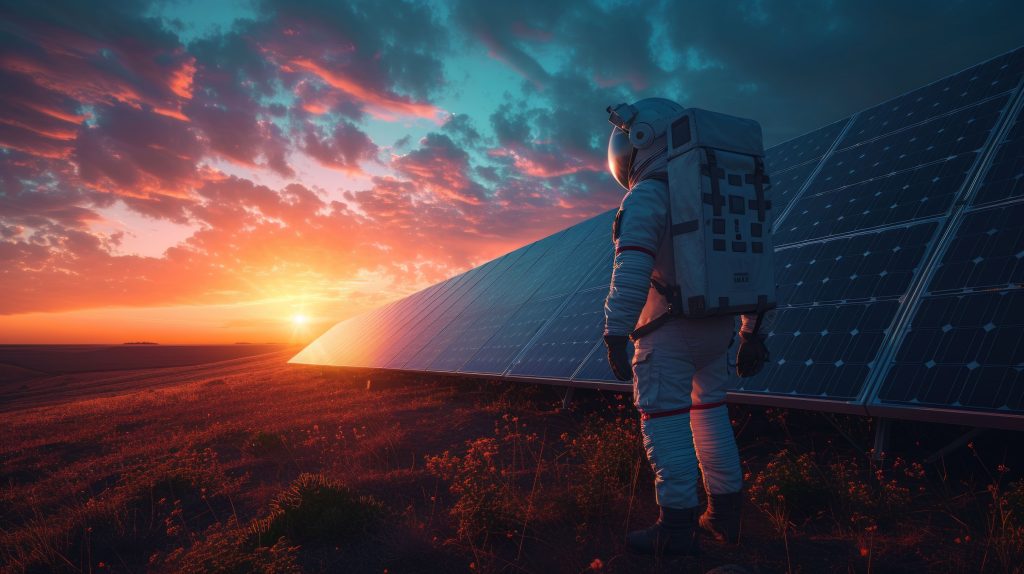In the process of shifting towards renewable energy, solar energy is among the most viable solutions in the world today. India is one of the countries that is most suited for this shift due to its abundant sunlight and its renewable energy targets. However, the full exploitation of solar energy has its own unique problems. This is where artificial intelligence (AI) comes in, an innovative technology that is revolutionizing solar energy production, management, and optimization. In this blog, let us discuss how the future of solar energy and AI are connected and how AI applications are fueling the solar energy growth in India.
1. AI Applications in Solar Energy: Transforming Efficiency
Transforming EfficiencyAI is one of the most fascinating technologies because it can work with big data and come up with conclusions that a human would not be able to make. AI in solar energy is the use of artificial intelligence and machine learning to analyze solar panels, forecast energy production, and enhance system efficiency. In India, for instance, the climate is quite diverse and AI can be used to optimize the efficiency of solar panels depending on the climate of the region. For example, machine learning algorithms can learn how much sunlight panels will get and then reposition them based on the data. This helps to guarantee that solar energy production is optimal irrespective of the season or geographical region. These AI-based optimizations are especially helpful for large solar farms, for example, in Rajasthan and Gujarat where conditions are severe. AI plays a role in maintaining these systems at optimal levels and minimizing energy losses in the process.
2. Predictive Analytics for Solar Performance
Another application of AI that is making a huge difference is the use of predictive analytics for solar performance. Solar power is inherently intermittent; the amount of energy generated is a function of the weather, the time of day, and even the season. AI can be used to forecast future energy output based on historical data and weather patterns in the case of operators. For instance, in a region such as Maharashtra, monsoons can be a major factor that limits the amount of sunlight, and this can be predicted using analytics. They can plan their energy distribution and storage in a better way rather than being surprised by cloudy days or rain. Thus, AI is assisting solar operators in India to achieve stable power generation, despite climate fluctuations. This not only guarantees a steady power source but also cuts down the cost of operating solar facilities.
3. Optimizing Solar Energy Output with AI
A ReviewEfficiency of solar energy production is important for both residential use of solar panels on rooftops and utility-scale solar power plants. Real-time monitoring and adjustment is one of the ways through which AI is achieving this. Solar panels are usually subjected to dust, debris, and other factors that may reduce the efficiency of the panels. In a country like India, where dust storms or pollution can hamper the efficiency of solar panels, AI-based systems can track the performance of each panel in real time and notify when cleaning is needed. This is a much more effective approach than regular maintenance or waiting for a problem to be identified by an operator. Since AI is able to monitor the efficiency of the solar panels, they are cleaned or repaired immediately they are detected to be producing less energy. Moreover, AI algorithms can adjust the angles of solar panels to follow the sun during the day. This enhances the amount of light that the panels capture, thus increasing their efficiency.
4. Smart Grid Technologies and AI Integration
The integration of AI into smart grid technologies is another way that artificial intelligence is shaping the future of solar energy in India. A smart grid allows for two-way communication between energy producers and consumers, creating a more flexible and reliable energy system. With AI, smart grids can analyze energy consumption patterns, predict demand, and efficiently distribute energy.
In India, where power outages are still common in some areas, the use of smart grids powered by AI can drastically improve the reliability of energy delivery. For example, during peak demand times, AI can help balance the grid by temporarily diverting energy from solar installations to where it’s needed most. This ensures that solar energy is not wasted during times of low demand and that energy is available during peak usage.
Furthermore, AI can manage energy storage systems, deciding when to store excess solar energy in batteries and when to release it back into the grid. This kind of smart management is essential for maintaining a stable energy supply, especially as India’s solar capacity continues to grow.
5. Machine Learning in Renewable Energy: Revolutionizing Solar
Revolutionizing SolarThe application of machine learning in renewable energy is creating new opportunities that were not possible ten years ago. AI algorithms can be trained to make better decisions about how to run solar systems in the future based on past data. These systems evolve over time and become more efficient in handling the generation and storage of energy. In India, where the solar energy sector is still growing fast, this technology can contribute to the acceleration of the shift to clean energy. With time, more data will be gathered from solar installations across the country and the machine learning systems will improve on performance, energy output, and grid stability. For example, AI can determine when a solar panel is likely to develop a fault and arrange for its repair before it fails. This predictive maintenance minimizes the time that solar installations are out of service and enhances the general life of solar systems. In the long run, it implies reduced maintenance expenses and optimum utilization of energy resources.
6. AI’s Role in Expanding Solar Energy Access
Another great advantage of AI is that it can help increase the availability of solar energy in regions where it is scarce. In many parts of rural India, electricity is still scarce, and conventional energy networks are not always available. But, AI-powered solar systems can assist in providing clean and reliable energy to such areas. For instance, AI can assist in the operation of microgrids, which are small power networks that are not connected to the main grid. For instance, in the rural areas of India where it is hard to connect to the main grid, solar microgrids can be used to supply electricity. AI assists in managing these systems to guarantee that they provide power effectively and reliably.
Conclusion
The intersection of AI and the future of solar energy is full of exciting possibilities, particularly in a country like India where the demand for clean energy is growing. From optimizing energy production to improving grid reliability, AI applications in solar are transforming the way we generate and manage renewable energy.
As India continues its journey toward becoming a global leader in solar energy, AI and machine learning will play a critical role in shaping the future of the country’s energy landscape. With the right investments and innovations, AI can help India not only meet its renewable energy goals but also create a more sustainable and energy-secure future for all its citizens.




